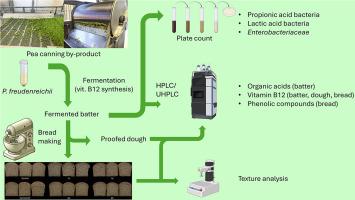青豌豆罐头副产物作为弗氏丙酸菌发酵强化面包维生素B12的底物
IF 8.2
Q1 FOOD SCIENCE & TECHNOLOGY
引用次数: 0
摘要
本研究的重点是通过原位发酵和随后的面包强化,对绿色豌豆罐头的工业副产品进行升级再利用,以生产维生素B12。该副产物富含蛋白质(24.3 g/100 g干物质)和膳食纤维(33.2 g/100 g干物质),经弗氏丙酸杆菌DSM 20271发酵后,维生素B12产量显著(1374 ~ 1535 ng/g DM)。然后将发酵物质以两个水平(面团重量的15%和20%)添加到小麦面包中,旨在解决严格以植物为基础的饮食中维生素B12缺乏的问题。40至70克强化面包提供了推荐的每日维生素B12摄入量(成人每天2.4 μg),与对照组相比,体积发育损失最小,质地也没有显著差异。在面包中添加未发酵或发酵的豌豆副产品面糊只增加了可溶性共轭和不溶性结合对香豆酸的含量。该研究强调了利用食品级副产品提高植物性产品营养价值的潜力,同时也有助于减少食物浪费。本文章由计算机程序翻译,如有差异,请以英文原文为准。

By-product of green pea canning as a substrate for Propionibacterium freudenreichii fermentation to fortify bread with vitamin B12
This study focused on upcycling the industrial by-product of canned green peas for the production of vitamin B12 by in-situ fermentation and subsequent bread fortification. The by-product, rich in protein (24.3 g/100 g dry matter, DM) and dietary fibre (33.2 g/100 g DM), was fermented with Propionibacterium freudenreichii DSM 20271, resulting in a significant vitamin B12 production (1374–1535 ng/g DM). The fermented material was then incorporated into wheat bread at two levels (15 and 20 % on the dough weight), aiming to address the deficiency of vitamin B12 in strictly plant-based diets. From 40 to 70 g of fortified bread provided the recommended daily allowance of vitamin B12 (2.4 μg/day for adults), along with minimal losses in volume development and no significant differences in texture when compared to the controls. The addition of non-fermented or fermented pea by-product batter in breads increased only the content of soluble conjugated and insoluble bound p-coumaric acid. The study underscores the potential of using food-grade by-products for enhancing the nutritional value of plant-based products, while also contributing to food-waste reduction.
求助全文
通过发布文献求助,成功后即可免费获取论文全文。
去求助
来源期刊

Future Foods
Agricultural and Biological Sciences-Food Science
CiteScore
8.60
自引率
0.00%
发文量
97
审稿时长
15 weeks
期刊介绍:
Future Foods is a specialized journal that is dedicated to tackling the challenges posed by climate change and the need for sustainability in the realm of food production. The journal recognizes the imperative to transform current food manufacturing and consumption practices to meet the dietary needs of a burgeoning global population while simultaneously curbing environmental degradation.
The mission of Future Foods is to disseminate research that aligns with the goal of fostering the development of innovative technologies and alternative food sources to establish more sustainable food systems. The journal is committed to publishing high-quality, peer-reviewed articles that contribute to the advancement of sustainable food practices.
Abstracting and indexing:
Scopus
Directory of Open Access Journals (DOAJ)
Emerging Sources Citation Index (ESCI)
SCImago Journal Rank (SJR)
SNIP
 求助内容:
求助内容: 应助结果提醒方式:
应助结果提醒方式:


